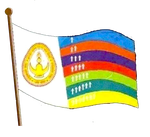
Gondwana is a historic region in central India which includes the states of Maharashtra, Chattisgarh, Telangana, Andhra Pradesh, Orissa and other states. It is inhabited by the Gonds, a group of Dravidian-speaking peoples exceeding 12 million in population, who are among the officially designated Scheduled Tribes. Click here for further information

The term 'Gondwana' also refers to the southern supercontinent, originally Gondwanaland which included most of the landmasses which make up today's continents of the southern hemisphere, including Antarctica, South America, Africa, Madagascar, India, Arabia, Australia-New Guinea and New Zealand.
